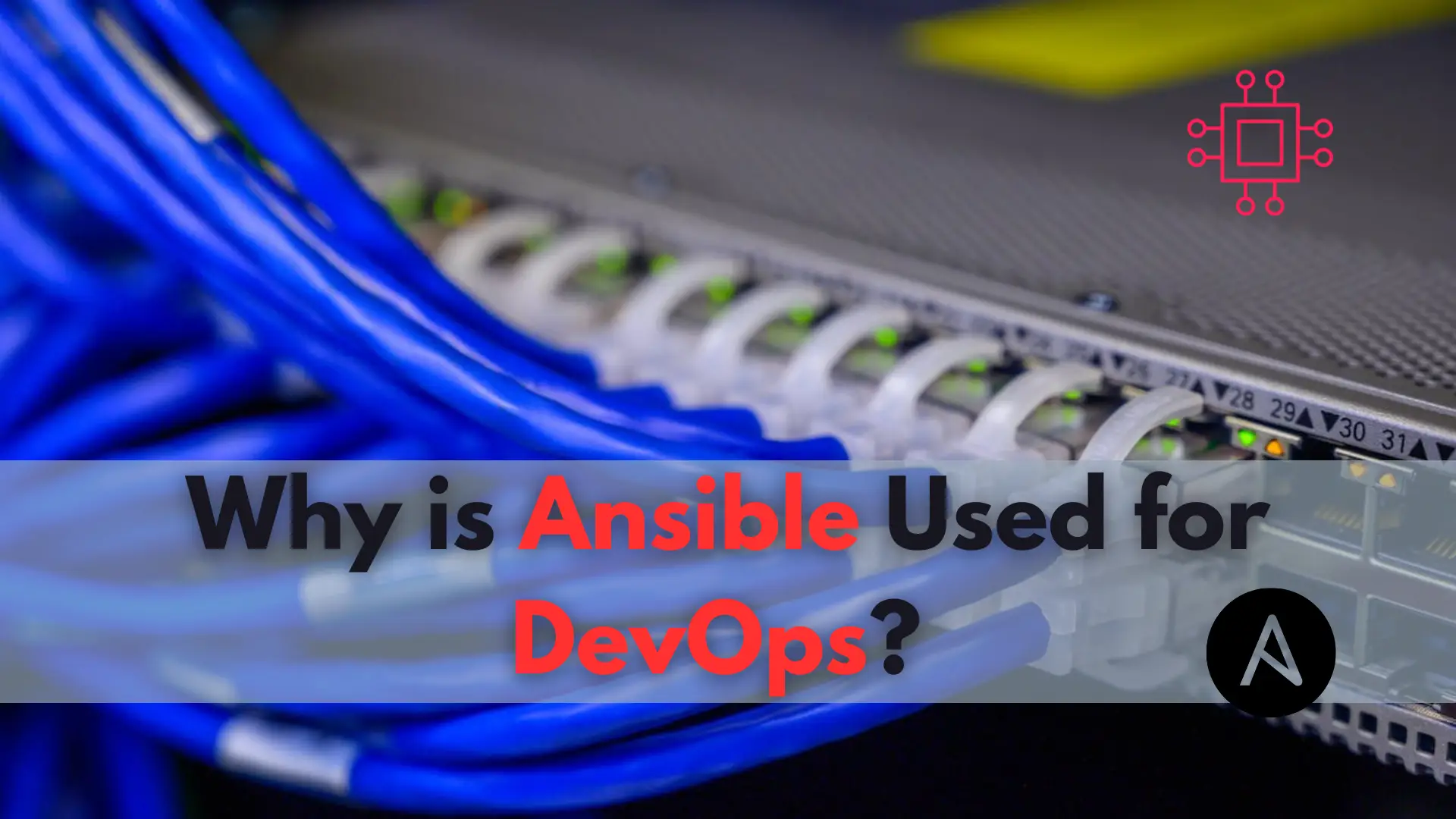
In this blog post, we’ll explore 12 best practices to help you organize your Ansible playbooks for optimal performance and maintainability. Table of Contents Introduction

If you’ve ever wondered, “Why is Ansible Used for DevOps?” this article is for you. Discover the compelling reasons behind Ansible’s widespread adoption in the DevOps landscape as we unravel its pivotal role in orchestrating seamless automation and driving operational excellence.
In today’s fast-paced digital landscape, DevOps has become a cornerstone for many organizations aiming to streamline their development and operations processes. Among the plethora of tools available, Ansible stands out as a powerful and versatile automation tool that simplifies configuration management, application deployment, and orchestration tasks.

Photo by admingeek from Infotechys
Let’s delve into the top 10 reasons why Ansible is an indispensable tool for DevOps teams.
Ansible’s simplicity is one of its most attractive features. With its agentless architecture and YAML-based syntax, getting started with Ansible is straightforward. Unlike other tools that require complex configurations, Ansible’s “Infrastructure as Code” approach allows you to describe your desired state in a human-readable format, making it easy to understand and maintain.
Before Ansible: Back in the day, getting your infrastructure up and running meant going on a manual marathon, typing commands on each server one by one. Not only was it a total time-suck, but it was also a breeding ground for mistakes. To top it off, configuration files were like scattered puzzle pieces, making it a real challenge to keep everything in sync. |
After Ansible: With Ansible in your corner, setting up servers and rolling out apps is as easy as pie. You just whip up these things called playbooks using simple YAML, which is like writing down your to-do list in plain English. This cool setup means you can manage everything from one central spot, making sure all your servers are singing the same tune without breaking a sweat. |
Unlike many other automation tools, Ansible doesn’t require agents to be installed on target systems. This eliminates the need for ongoing management and updates of agents, reducing complexity and potential security vulnerabilities.
Before Ansible: So, a bunch of those old automation tools needed you to slap on these little agents onto every system you wanted to manage. It was like sticking name tags on all your friends at a party. But here’s the kicker – those agents were a hassle to keep track of. You had to babysit them, making sure they were always up-to-date and not causing any trouble. Talk about extra work and a security headache! |
After Ansible: With Ansible, it’s like skipping the whole “stick a sticker on everyone” part. You don’t need those pesky agents cluttering up your systems. It’s like having a party without name tags – way simpler! Plus, without those agents hogging space, your systems are less vulnerable to sneak attacks. And the best part? You can still boss your systems around from afar without any of the agent babysitting. Easy peasy! |
Ansible ensures idempotent execution, meaning that running the same playbook multiple times will result in the same desired state, regardless of the initial state of the system. This guarantees consistency and reliability in your infrastructure management tasks.
Before Ansible: Back in the old days of scripting, if you kept hitting the same buttons over and over again, things could get messy. It’s like trying to follow a recipe but messing up the order of ingredients – your infrastructure could end up in a bit of a pickle. Making sure everything stayed on track was like trying to herd cats. Chaos, right? |
After Ansible: Think of Ansible as your personal organizer that always keeps things in check. When you run a playbook multiple times, it’s like asking your organizer to tidy up your room over and over again. No matter how messy your room was to start with, Ansible makes sure it ends up looking the same way every time. So, whether you’re setting up servers or deploying applications, you can count on Ansible to keep things consistent and reliable. |
It’s modular design allows for easy integration with other tools and technologies. Whether you need to orchestrate Docker containers, provision cloud resources, or configure network devices, Ansible’s extensive library of modules has you covered.
Before Ansible: Trying to mix and match different tools and tech was like trying to solve a puzzle with pieces from different sets. You had to cook up your own special sauce of custom scripts just to get them to play nice together. And don’t get me started on the compatibility issues – it was like trying to fit a square peg into a round hole. Keeping track of all the moving parts and updates was like trying to juggle flaming torches. Not exactly a walk in the park! |
After Ansible: Think of Ansible like a Swiss Army knife for your IT toolkit. It’s got all these neat little gadgets (we call them modules) that can handle all sorts of tasks. Need to wrangle some Docker containers? Ansible’s got your back. How about setting up your network devices? No sweat for Ansible. It’s like having a one-stop shop for managing your whole IT setup, no matter how diverse it gets. |
It promotes code reuse through roles and playbooks. Roles encapsulate reusable sets of tasks, making it easy to standardize configurations across different environments. This modular approach not only enhances maintainability but also accelerates development by leveraging existing components.
Before Ansible: Imagine having to write out a whole new recipe every time you wanted to cook a meal. Talk about a recipe for disaster! That’s what it was like trying to whip up scripts from scratch for every little task. Not only was it a major time drain, but it also led to a hot mess of different configurations floating around. It was like trying to herd cats – impossible to keep everything in line. |
After Ansible: Just like a treasure chest full of handy tools, roles and playbooks can stash away sets of tasks like hidden gems, ready to pull out whenever you need them. It’s like having a secret stash of your favorite snacks – always there when you need a quick fix. This clever setup not only keeps things tidy but also speeds up the whole process. Instead of reinventing the wheel every time, you can just grab what you need and hit the ground running. |
Additionally, Ansible scales effortlessly from small, single-server deployments to large, complex infrastructures spanning multiple data centers. Its push-based model allows you to manage thousands of nodes simultaneously, making it ideal for organizations with dynamic and growing infrastructures.
Before Ansible: Picture this: managing a massive infrastructure was like trying to tame a dragon – a colossal, time-devouring monster. Doing it all by hand was a total headache, sucking up valuable time and resources faster than you can say “tech nightmare.” Traditional methods just couldn’t keep up with the wild, ever-changing landscape of large and dynamic environments. It was like trying to fit an elephant through a mousehole – not the smoothest experience, to say the least. |
After Ansible: Now imagine Ansible as a superhero that can go from handling a cozy little one-person job to taking on a whole city-saving mission without breaking a sweat. Whether you’ve got a tiny setup or a sprawling network spread across multiple data centers, Ansible’s got the muscle to handle it all. With its push-based model, you can give commands to thousands of devices at once, like orchestrating a perfectly synchronized dance routine. |
When it comes to versatility, Ansible extends beyond traditional server management. Whether you’re automating cloud provisioning, configuring network devices, or deploying applications in containers, Ansible provides a unified platform for managing diverse IT environments.
Before Ansible: Managing your IT setup was like trying to juggle a bunch of different balls at once – each one requiring its own special trick to keep in the air. You had one tool for servers, another for networks, and yet another for your applications. It was like trying to solve a Rubik’s Cube blindfolded! With all these tools doing their own thing, achieving a unified management experience was nearly impossible. |
After Ansible: With Ansible, there’s a tool for every job. Whether you’re tinkering with cloud setups, tweaking your network, or diving into the world of containers, Ansible’s got your back. It’s like having a super-smart assistant who can handle anything you throw at it. |
The vibrant community surrounding Ansible is like a bustling marketplace, where users and contributors come together to share their wisdom and expertise. They’re like a big family, always ready to lend a helping hand and share their secret sauce for success. This community-driven approach not only speeds up development but also makes troubleshooting a breeze. It’s like having a whole team of experts in your corner, cheering you on as you tackle your DevOps challenges and reach new heights of efficiency.
Before Ansible: Solving tough automation puzzles was like trying to crack a secret code – you either had to be a genius or fork over big bucks for help. But here’s the kicker: teamwork and sharing were kind of like locked doors, making it tough to spread the word on what really worked. It was like trying to learn a new trick without anyone showing you the ropes. |
After Ansible: Ansible’s community is like a bustling marketplace where everyone’s trading tips and tricks. It’s like a big family cookout where everyone brings their secret recipes to share. With all this collective brainpower, development becomes a breeze, and troubleshooting? Piece of cake! This community vibe isn’t just about making friends – it’s about turbocharging your DevOps game and reaching those goals faster than ever. |
With Continuous Integration/Continuous Deployment (CI/CD) pipelines, Ansible seamlessly enables automated deployments and infrastructure provisioning as part of your software delivery process. By automating repetitive tasks, Ansible enhances the speed and reliability of your release cycles.
Before Ansible: Trying to fit automation into CI/CD pipelines was like trying to cram a square peg into a round hole – it just didn’t quite fit right. You had to whip up all sorts of custom scripts and juggle complex setups just to keep things running smoothly. Not to mention trying to keep everything in sync between development, testing, and production. |
After Ansible: When you bring Ansible into the mix with your CI/CD pipelines, it’s like adding a magic touch to your software delivery process. Suddenly, deployments happen like clockwork, and setting up the infrastructure is a breeze. With Ansible taking care of the nitty-gritty repetitive tasks, your release cycles become lightning-fast and super reliable. |
Finally, Ansible is open source and available for free, making it a cost-effective solution for organizations of all sizes. By automating manual tasks and reducing human error, Ansible helps optimize resource utilization and minimize operational costs.
Before Ansible: Getting automation up and running was like diving into a money pit – you had to splash out big bucks on fancy tools and licenses just to get started. For organizations on a shoestring budget, it was like hitting a brick wall. The cost of ownership was sky-high, making it feel like automation was just out of reach. |
After Ansible: Ansible, like a gift from the tech heavens – is totally free! Whether you’re a big shot corporation or a small startup, it doesn’t cost you a dime. And here’s the kicker: by automating those tedious manual tasks and putting the brakes on human error, Ansible helps you squeeze every last drop of value out of your resources. |
With its simplicity, agentless setup, versatility, and scalability, using Ansible is like hitting the jackpot for DevOps teams. It’s not just about making automation easier – it’s about turbocharging your whole operation. By making Ansible a central piece of your DevOps toolkit, you’re not just streamlining processes – you’re supercharging innovation, fostering collaboration, and giving your organization the agility it needs to stay ahead in today’s fast-paced tech world.
Did you find this article useful? Your feedback is invaluable to us! Please feel free to share your thoughts in the comments section below.
Related Posts

In this blog post, we’ll explore 12 best practices to help you organize your Ansible playbooks for optimal performance and maintainability. Table of Contents Introduction

In this article, we’ll explore 10 Must-Read books about Ansible, meticulously curated to cater to Ansible administrators across all proficiency levels, ranging from novices to

In this article, we will examine 10 ways to speed up your Ansible Playbooks, providing actionable strategies and examples to optimize performance and streamline automation
